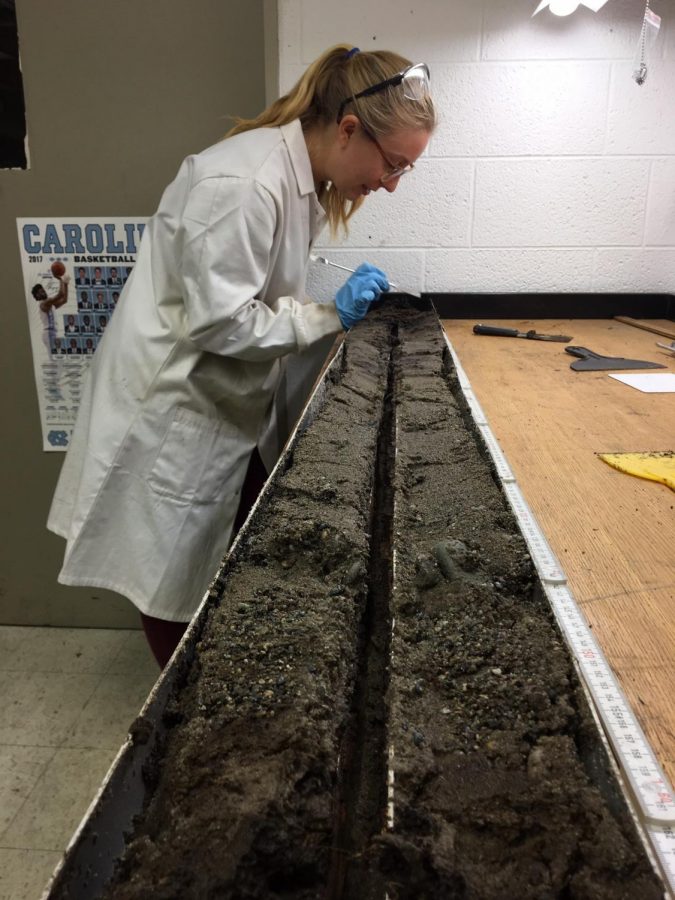Freshwater coastal erosion alters global carbon budget
Photo Courtesy of Katherine Braun
Katherine Braun samples soil cores in the laboratory as part of her research on shoreline erosion.
Apr 10, 2019
Last updated on April 24, 2019 at 02:48 p.m.
Illinois State Geological Survey researchers from the University found that shoreline erosion can transform freshwater wetlands from carbon storage pools to carbon sources.
Katherine Braun, ISGS researcher from Northwestern University and lead author of the study, began the project in the fall of 2017 after a storm exposed wetland to wave action and burial by beach sand at the shoreline of Lake Michigan at Illinois Beach State Park.
“Throughout the summer, when I was working there, we’ve seen that study site, this wetland that wasn’t protected by a beach range. We could see that there is this dark, organic-rich wetland soil that was being swept to Lake Michigan,” Braun said. “We knew that there was some sort of process that was happening with this carbon-rich soil that was being washed by Lake Michigan.”
Braun said the beach is unique because it contains some of the only natural coastlines without human modification.
Get The Daily Illini in your inbox!
“There are plenty of coastal wetlands along Illinois Beach State Park and there are lots of others in the Great Lakes Region, but not specifically along the Illinois shoreline,” Braun said.
Daniel Horton, Braun’s advisor in the project, said in an email that tracking carbon in the Earth is critical.
“It allows us to better understand the movements and residence times of carbon in Earth’s movements and residence times of carbon in earth’s various reservoirs,” Horton said. “It assists us in making predictions about where the carbon is and how long it will stay there.”
The study did not aim to identify what was causing the erosion but worked to understand how much carbon is lost when erosion occurs.
“We went out after every single storm. We captured one storm in October 2017. We saw in our record of survey that it had an influence of reducing the rate of which the wetland was being covered,” Braun said.
Braun said this study is the first model for calculating the carbon budget of eroding wetland in freshwater ecosystems.
“The unique thing about the study is that you can modify (the) model for use in a specific habitat, so we can say we can use this throughout the state and in Champaign,” Braun said.
Horton said the key uncertainty with regards to Earth’s carbon budget is freshwater wetlands.
“Though we do not think (freshwater wetlands) hold a lot of carbon, it is still important to understand them,” Horton said. “Beyond the immediate importance of the study, it is important for us to understand carbon, and especially carbon dioxide in the atmosphere, because of global climate change.”
Braun said they don’t focus on the carbon that is being released from the soil if it is going to alter the freshness of water as it is another geochemical question.
“We are not interested in the carbon entering Lake Michigan because we are considering this carbon stored in the soil as it’s not contributing to climate change,” Braun said.
The next steps are to expand the model from this specific wetland in the North Unit of Illinois Beach to the entire shoreline of the beach.
Braun said a separate project, in partnership with the Midwestern Regional Climate Center at the University, is under way. The project ties these changes in the shoreline to climatic change.
“We are expanding the model to different types of habitats and we are looking at the change in the carbon budget of the shoreline throughout the past 100 years,” Braun said. “We are interested in how the past 100 years has affected the carbon budget, because there has been a large amount of erosion throughout the entire northern portion of Illinois Beach.”
Horton said any carbon additions to the atmosphere, whether they are natural or caused by humans, will play a role in global warming and the impacts of climate change.
“Studying freshwater wetlands will help us better their carbon contribution to the atmospheric reservoir,” Horton said.
Braun said there are always more avenues to explore when it comes to researching soil carbon.
“We are looking at change over longer time scales, change in different habitats and areas, processes and climate change — what might happen in the future — and we’re also looking at how the carbon exiting these coastal environments is travelling throughout different geochemical pathways,” Braun said. “We will never reach a point where it’s done, because this research always open up new questions.”
Correction: A previous version of this article misquoted many of Braun’s comments, including mistaking “processes” for “prophecies,” “eroding” for “rotting” and “coastal wetlands” for “coasts of wetlands,” among others. The Daily Illini regrets these errors.






